Factors Impacting Risk Perception under Typhoon Disaster in Macao SAR, China
Abstract
1. Introduction
2. Materials and Methods
2.1. Study Setting
2.2. Study Participants
2.3. Data Collection
2.3.1. Survey Design
2.3.2. Pre-Investigation
2.4. Statistical Analysis
3. Results and Discussion
3.1. Demographic Characteristics and Other Information of Participants
3.1.1. Demographic Characteristics of Participants
3.1.2. Other Personal Information of Participants
3.2. Typhoon Information
3.2.1. Knowledge of Typhoon Disaster Prevention
3.2.2. Information Channels on Risk Communication
3.3. Risk Perception of Residents before Typhoon
3.4. Active Response for Typhoon
3.5. Factors Influencing Residents’ Risk Perception—Multivariable Analysis
3.5.1. Comparison Analysis of Risk Perception based on Demographic Characteristics and Correlation Analysis between Them
3.5.2. Comparison Analysis of Risk Perception based on other Personal or Family Circumstances and Correlation Analysis between Them
3.5.3. Comparison Analysis of Risk perception based on Knowledge and Correlation Analysis between Them
3.5.4. Comparison Analysis of Risk Perception based on Information Channels and Correlation Analysis between Them
3.5.5. Comparison Analysis of Active Response to Typhoon based on Risk Perception and Correlation Analysis between them
3.5.6. Coupling Analysis of Knowledge, Information channels and Risk perception
4. Conclusions and Prospects
4.1. Conclusions
4.2. Prospects
Author Contributions
Funding
Acknowledgments
Conflicts of Interest
References
- PMF IAS. Tropical Cyclones: Favorable Conditions for Formation, Stages of Formation & Structure. 2016. Available online: https://www.pmfias.com/tropical-cyclones-favorable-conditions-tropical-cycloneformation/ (accessed on 6 January 2016).
- Mei, W.; Xie, S. Intensification of landfalling typhoons over the northwest Pacific since the late 1970s. Nat. Geosci. 2016, 9, 753–759. [Google Scholar] [CrossRef]
- Cohen, B.L. Public perception versus results of scientific risk analysis. Reliab. Eng. Syst. Saf. 1998, 59, 101–105. [Google Scholar] [CrossRef]
- Rogers, G.O. The dynamics of risk perception: How does perceived risk respond to risk events? Risk Anal. 1997, 17, 745–757. [Google Scholar] [CrossRef]
- Pidgeon, N. Risk assessment, risk values and the social science programme: Why we do need risk perception research. Reliab. Eng. Syst. Saf. 1998, 59, 5–15. [Google Scholar] [CrossRef]
- Slovic, P. Perception of risk. Science 1987, 236, 280–285. [Google Scholar] [CrossRef]
- Sjöberg, L.; Moen, B.E.; Rundmo, T. Explaining risk perception. An evaluation of the psychometric paradigm in risk perception research. Rotunde Publikasjoner 2004, 84, 55–76. [Google Scholar]
- Lai, J.; Tao, J. Perception of environmental hazards in Hong Kong Chinese. Risk Anal. 2003, 23, 669–684. [Google Scholar]
- Spence, H.E.; Engel, J.F.; Blackwell, R.D. Perceived risk in mail-order and retail store buying. J. Mark. Res. 1970, 7, 364. [Google Scholar] [CrossRef]
- Jackson, E.L. Response to Earthquake Hazard: The West Coast of North America. Environ. Behav. Behav. 1981, 13, 387–416. [Google Scholar] [CrossRef]
- Bettman, J.R.; Whan, P.C. Effects of prior knowledge and experience and phase of the choice process on consumer decision processes: A protocol analysis. J. Consum. Res. 1980, 7, 3. [Google Scholar] [CrossRef]
- Peacock, W.G.; Brody, S.D.; Highfield, W. Hurricane risk perceptions among florida’s single family homeowners. Landsc. Urban Plan. 2005, 73, 120–135. [Google Scholar] [CrossRef]
- Wei, J.; Wang, F.; Zhao, D. A risk perception model: Simulating public response to news reports in China. Inf. Res. 2012, 17, 519. [Google Scholar]
- Riad, J.K.; Norris, F.H.; Ruback, R.B. Predicting evacuation in two major disasters: Risk perception, social influence, and access to resources1. J. Appl. Soc. Psychol. 2006, 29, 918–934. [Google Scholar] [CrossRef]
- Matyas, C.; Srinivasan, S.; Cahyanto, I.; Thapa, B.; Pennington-Gray, L.; Villegas, J. Risk perception and evacuation decisions of florida tourists under hurricane threats: A stated preference analysis. Nat. Hazards 2011, 59, 871–890. [Google Scholar]
- Santos-Reyes, J.; Santos-Reyes, G.; Gouzeva, T.; Velazquez-Martinez, D. Schoolchildren’s earthquake knowledge, preparedness, and risk perception of a seismic-prone region of Mexico. Hum. Ecol. Risk Assess. 2017, 23, 494–507. [Google Scholar] [CrossRef]
- Wachinger, G.; Renn, O.; Begg, C.; Kuhlicke, C. The risk perception paradox-implications for governance and communication of natural hazards. Risk Anal. 2013, 33, 1049–1065. [Google Scholar] [CrossRef]
- Bodoque, J.M.; Díez-Herrero, A.; Amérigo, M.; García, J.A.; Olcina, J. Enhancing flash flood risk perception and awareness of mitigation actions through risk communication: A pre-post survey design. J. Hydrol. 2019, 568, 769–779. [Google Scholar] [CrossRef]
- Henry, L.; Takagi, H.; Viet, N.T.; The, N.N. Applicability of Stormwater—River Flood Combined Model in Low-Lying Delta: Disaster Survey in Hoi an and Model Assessment of 2017 Typhoon Damrey. In Proceedings of the APAC 2019 International Conference on Asian and Pacific Coasts, Hanoi, Vietnam, 25–28 September 2019; Trung Viet, N., Xiping, D., Thanh Tung, T., Eds.; Springer: Singapore, 2020. [Google Scholar]
- Alqahtany, A.M.; Abubakar, I.R. Public perception and attitudes to disaster risks in a coastal metropolis of Saudi Arabia. Int. J. Disaster Risk Reduct. 2020, 44, 101422. [Google Scholar] [CrossRef]
- Lam, R.P.K.; Leung, L.P.; Balsari, S.; Hsiao, K.H.; Newnham, E.; Patrick, K.; Pham, P.; Learning, J. Urban disaster preparedness of Hong Kong residents: A territory-wide survey. Int. J. Disaster Risk Reduct. 2017, 23, 62–69. [Google Scholar] [CrossRef]
- Chan, E.Y.Y.; Huang, Z.; Mark, C.K.M.; Guo, C. Weather information acquisition and health significance during extreme cold weather in a subtropical city: A crosssectional survey in Hong Kong. Int. J. Disaster Risk Reduct. 2017, 8, 134–144. [Google Scholar] [CrossRef]
- Greta, T.; Zhe, H.; Emily, C. Household preparedness and preferred communication channels in public health emergencies: A cross-sectional survey of residents in an Asian developed urban city. Int. J. Environ. Res. Public Health 2018, 15, 1598. [Google Scholar]
- Loke, A.Y.; Lai, C.K.; Fung, O.W.M. At-home disaster preparedness of elderly people in Hong Kong. Geriatr. Gerontol. Int. 2012, 12, 524–531. [Google Scholar] [CrossRef] [PubMed]
- Bollettino, V.; Alcayna, T.; Enriquez, K.; Vinck, P. Perceptions of Disaster Resilience and Preparedness in the Philippines; Harvard University: Cambridge, MA, USA, 2018. [Google Scholar]
- Chan, E.; Man, A.; Lam, H.; Chan, G.; Hall, B.; Hung, K. Is urban household emergency preparedness associated with short-term impact reduction after a super typhoon in subtropical city? Int. J. Environ. Res. Public Health 2019, 16, 596. [Google Scholar] [CrossRef] [PubMed]
- Pidgeon, N.; Kasperson, R.E.; Slovic, P. The Social Amplification of Risk; Cambridge University Press: Cambridge, UK, 2003; Available online: https://cllr.com.au/wp-content/uploads/2016/09/Social-Amplification-of-Risk-Perth.pdf (accessed on 9 October 2020).
- Ho, M.C.; Shaw, D.; Lin, S.; Chiu, Y.C. How do disaster characteristics influence risk perception? Risk Anal. Off. Publ. Soc. Risk Anal. 2008, 28, 635–643. [Google Scholar] [CrossRef] [PubMed]
- Kellens, W.; Terpstra, T.; Maeyer, P.D. Perception and communication of flood risks: A systematic review of empirical research. Risk Anal. 2013, 33, 24–29. [Google Scholar] [CrossRef]


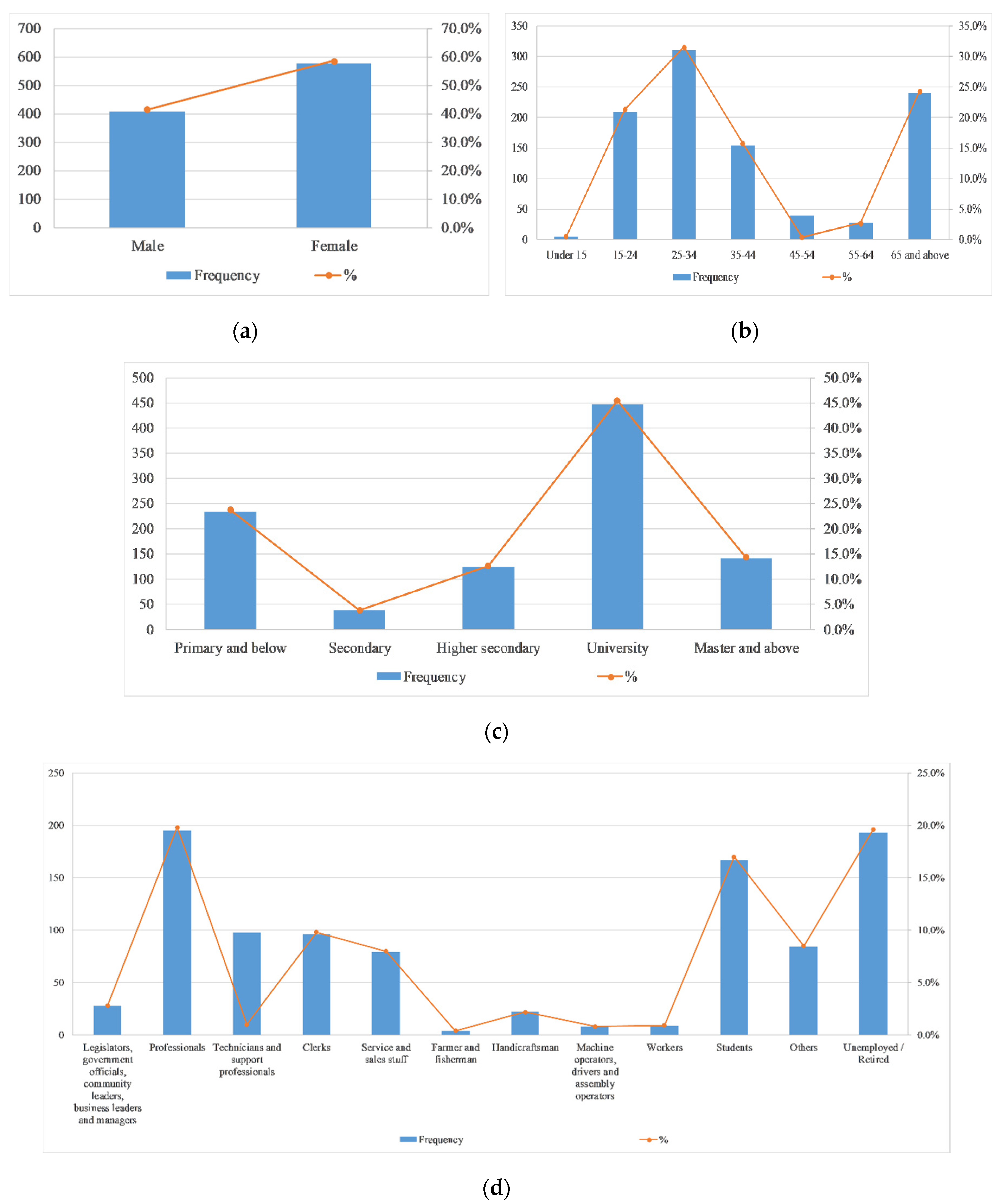
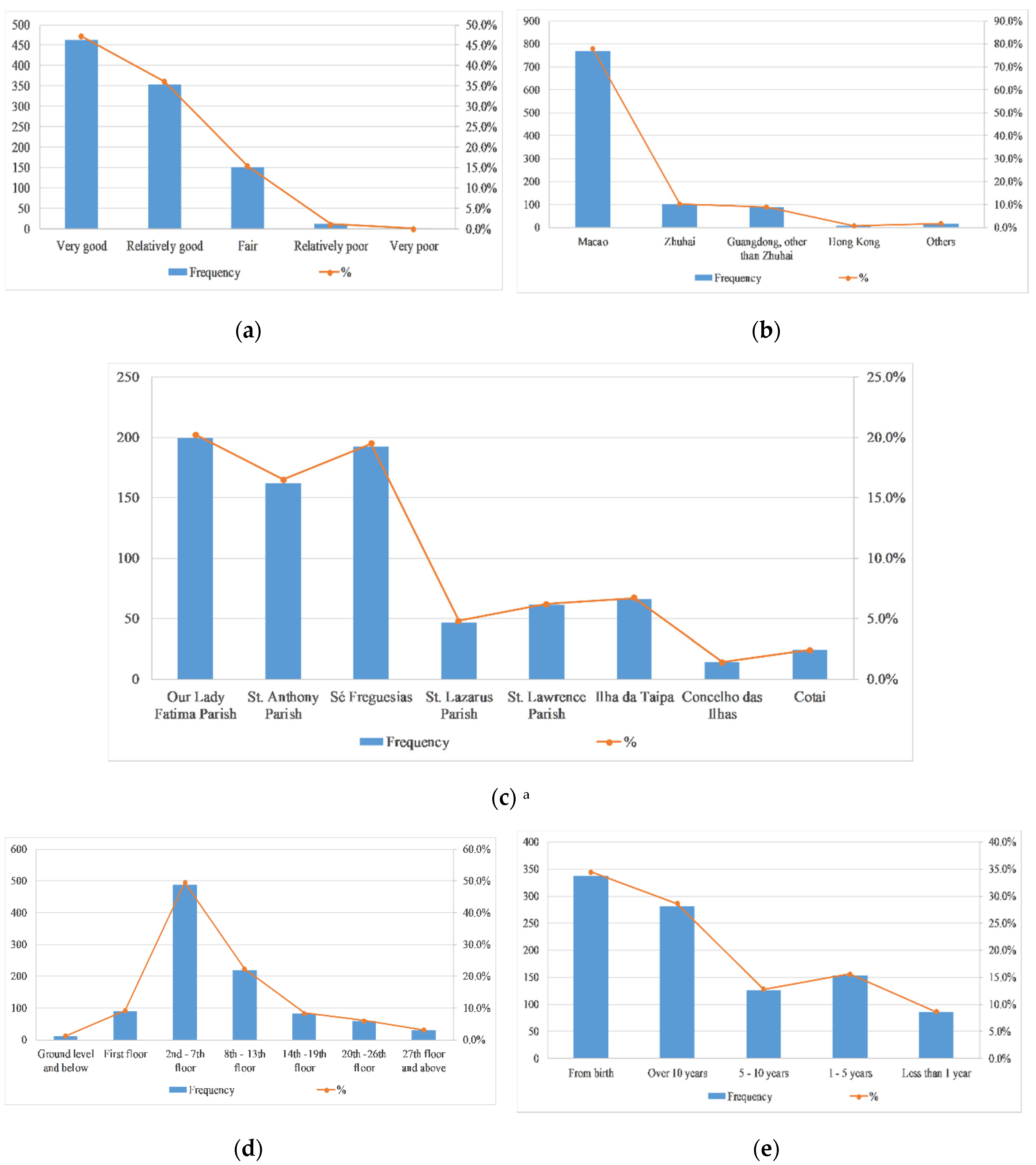
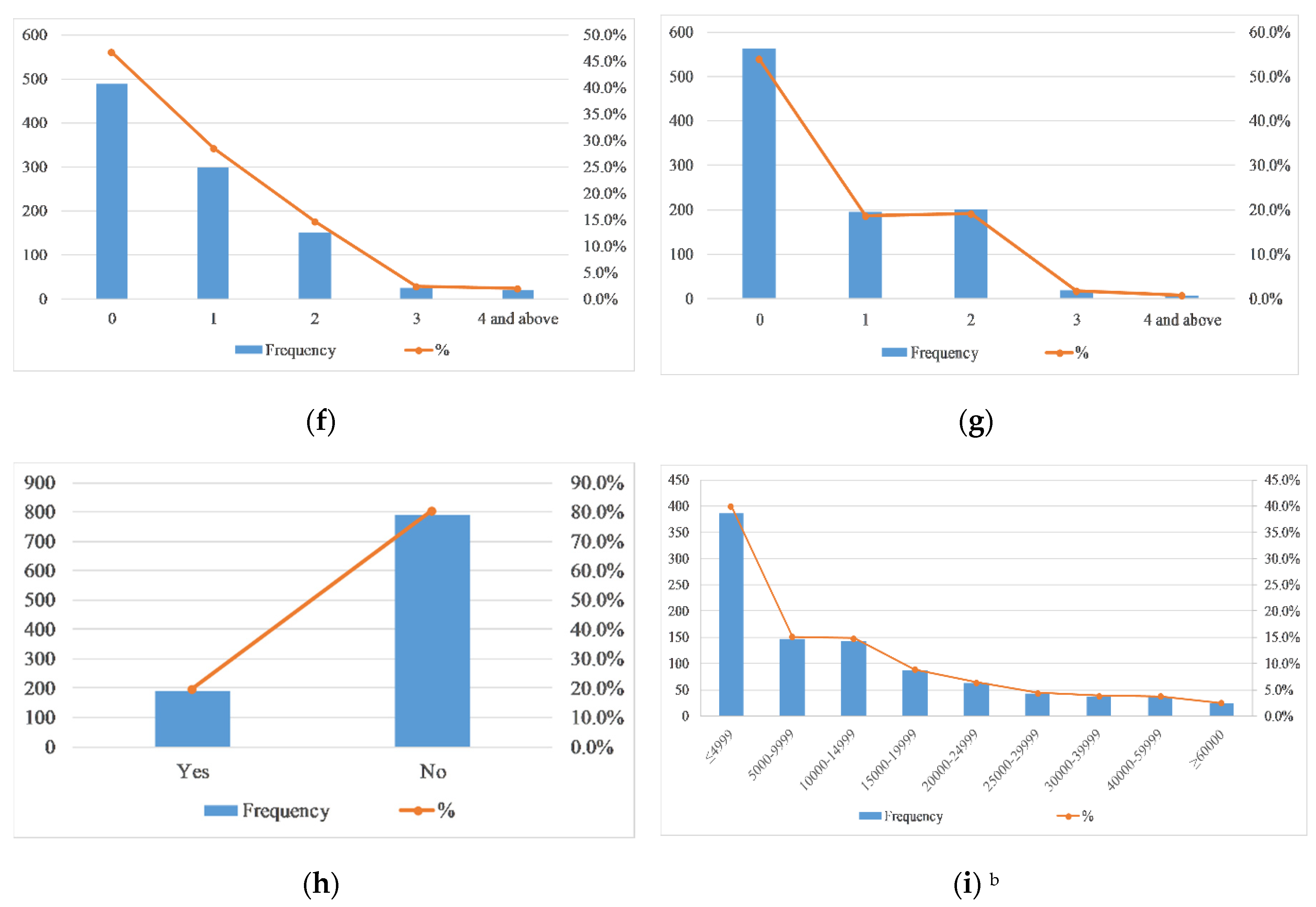
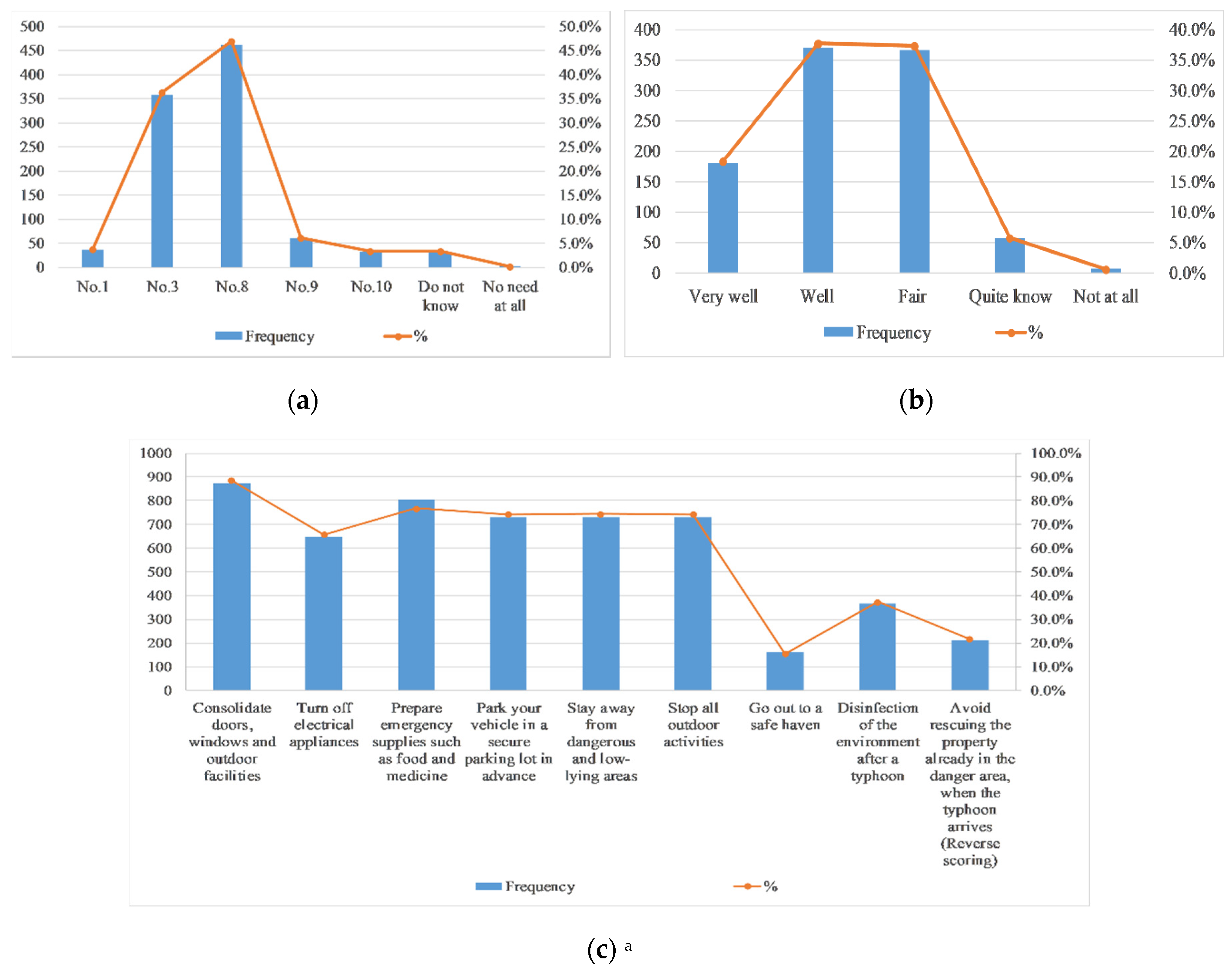
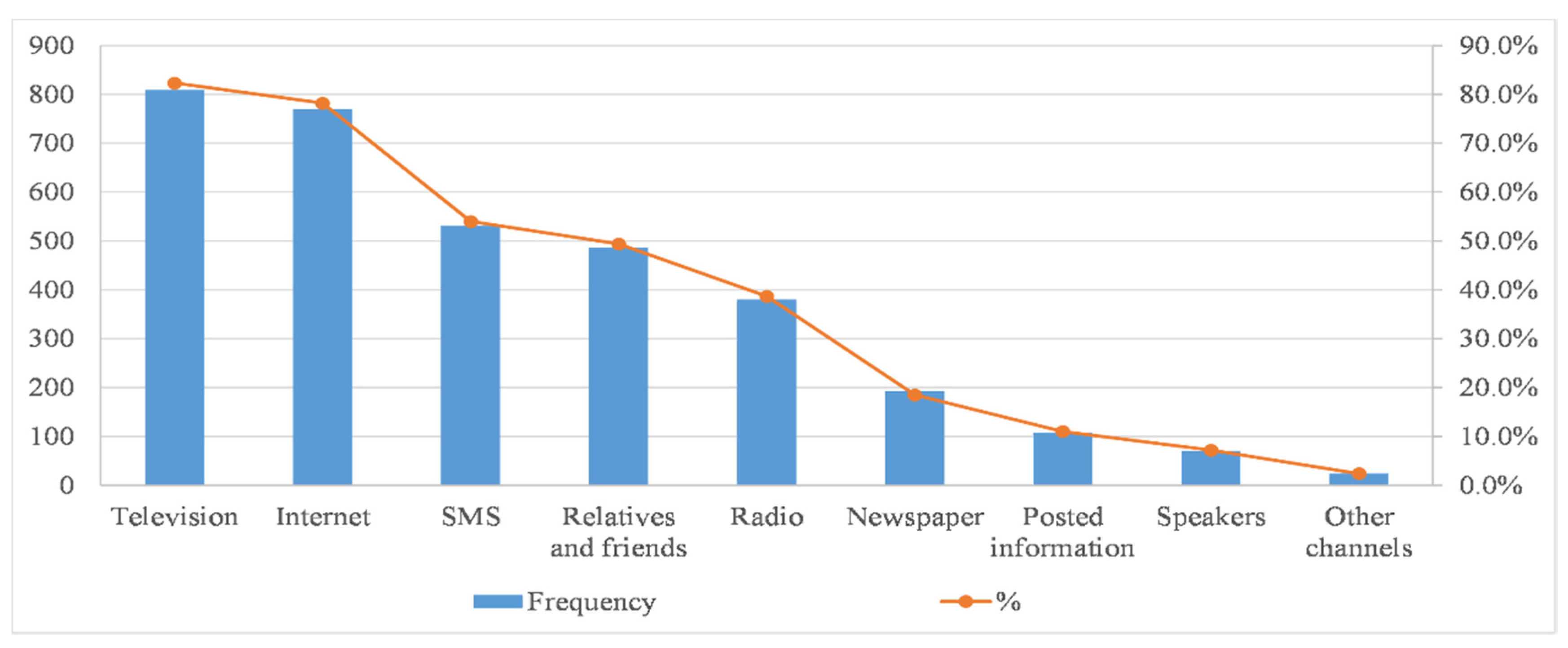
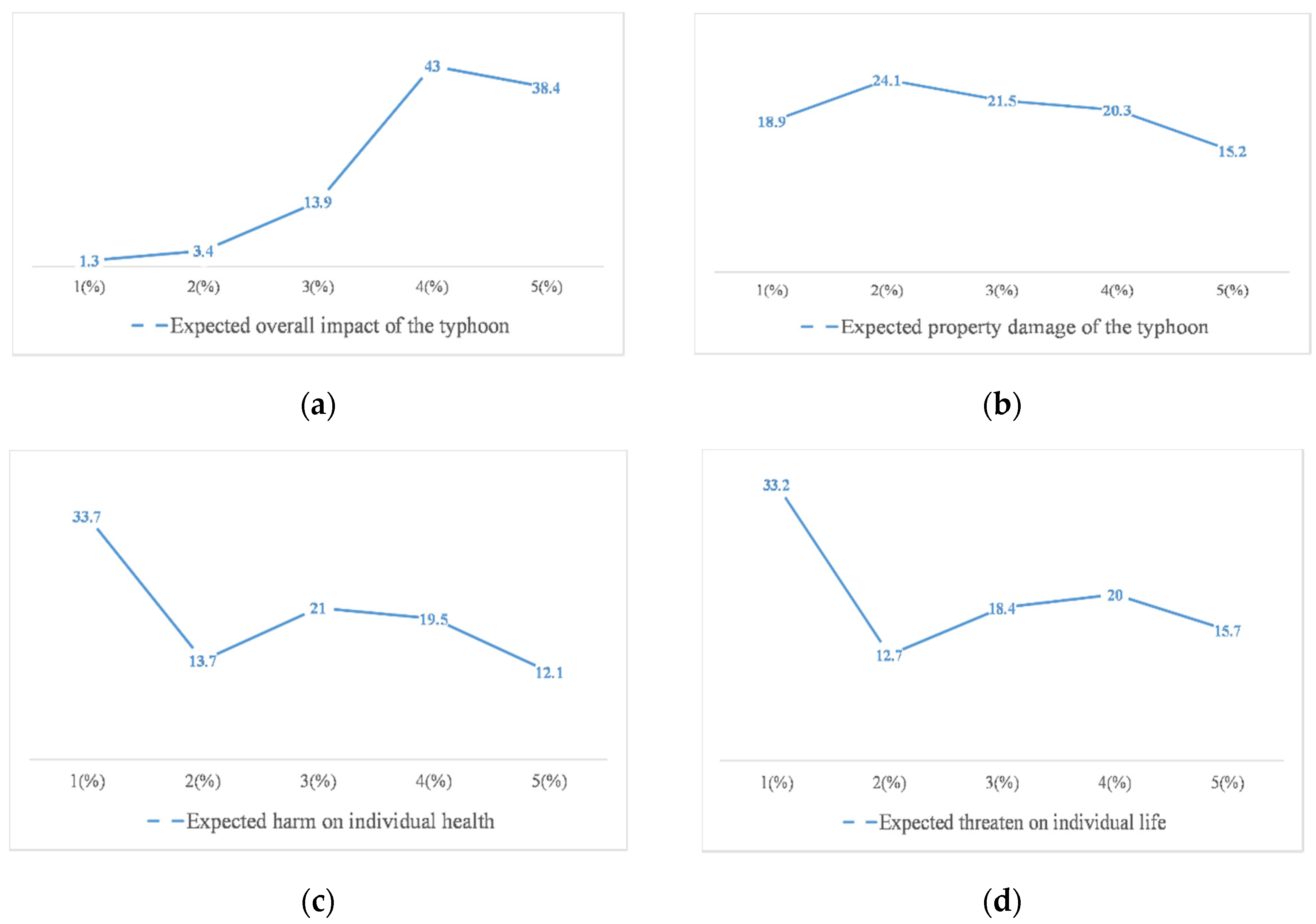
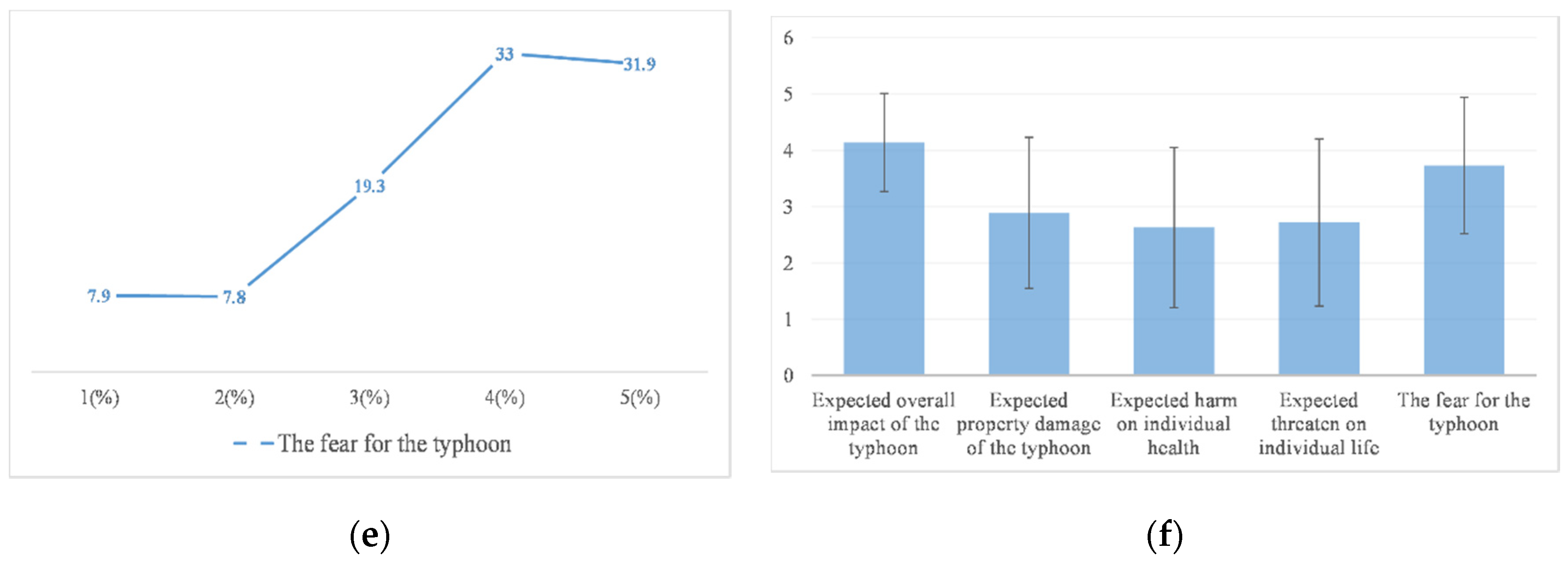
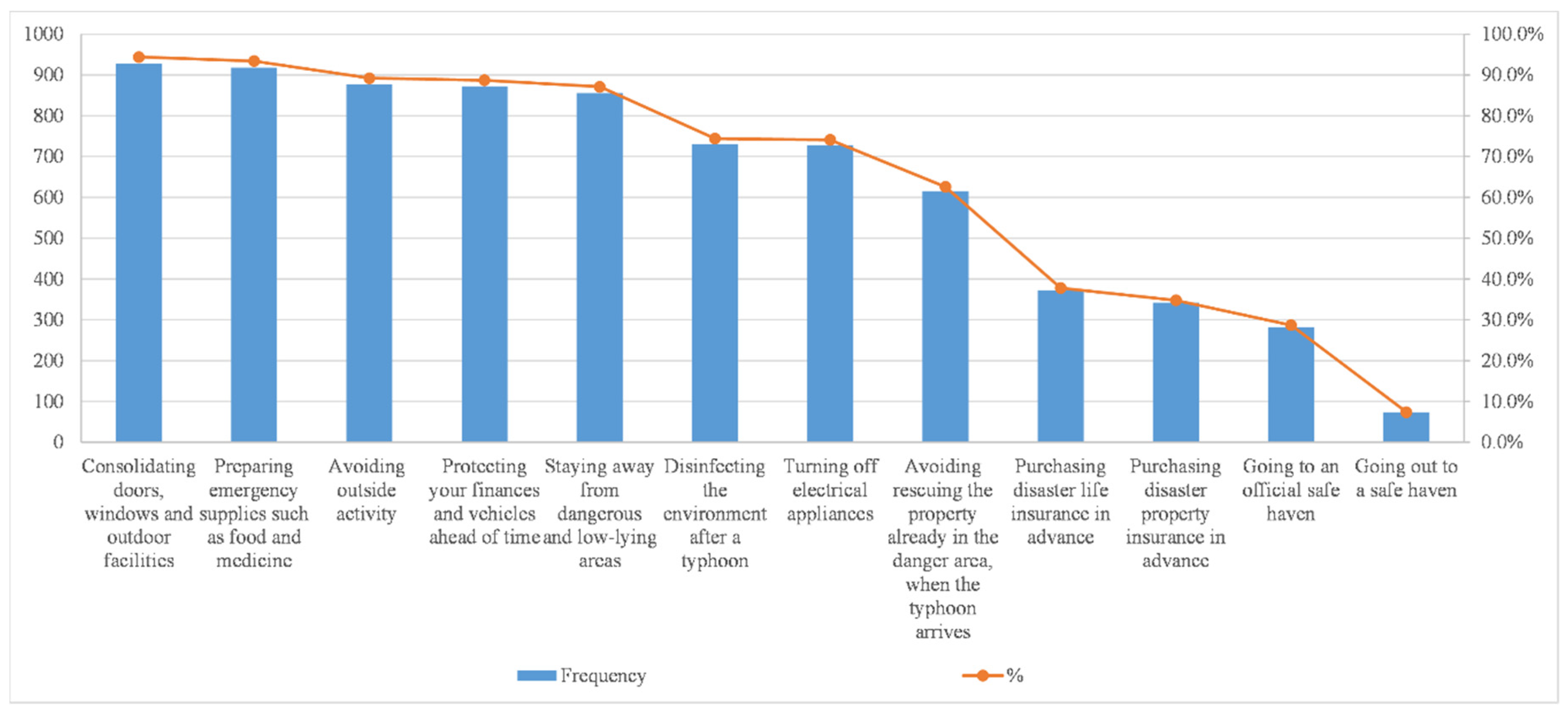
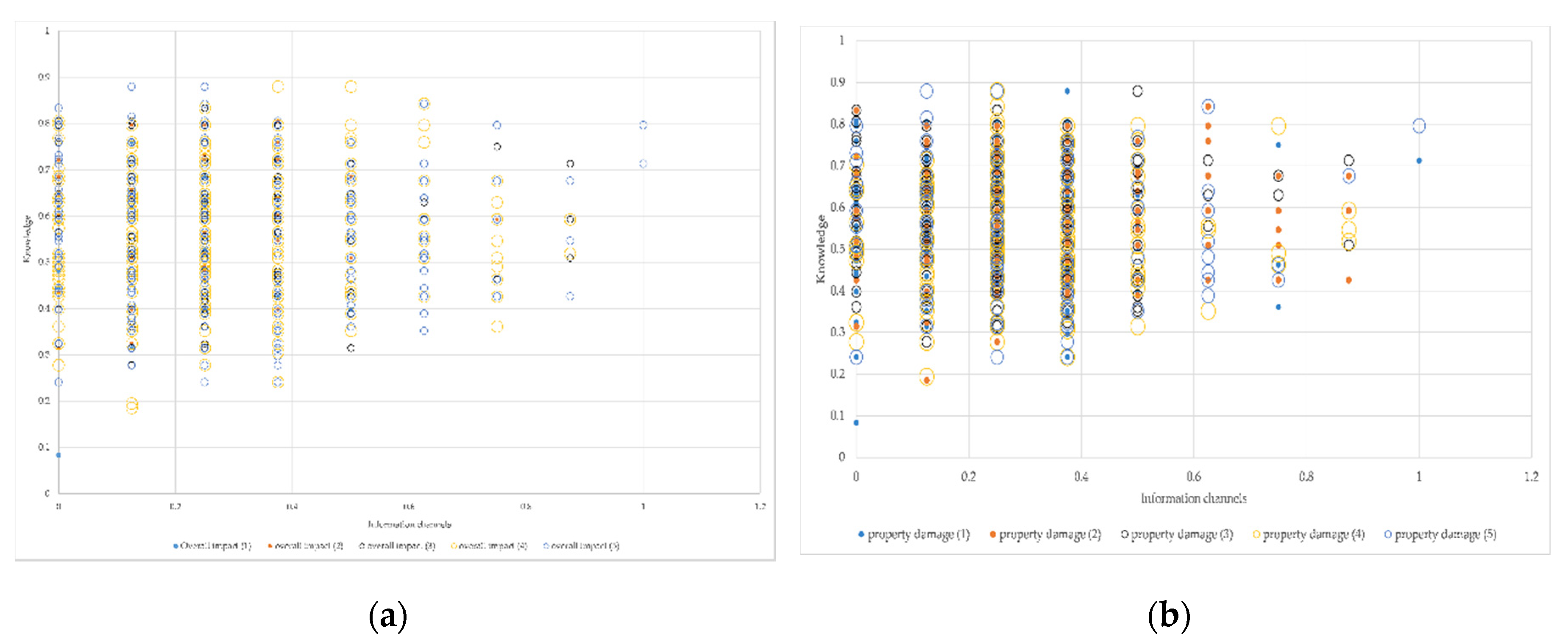
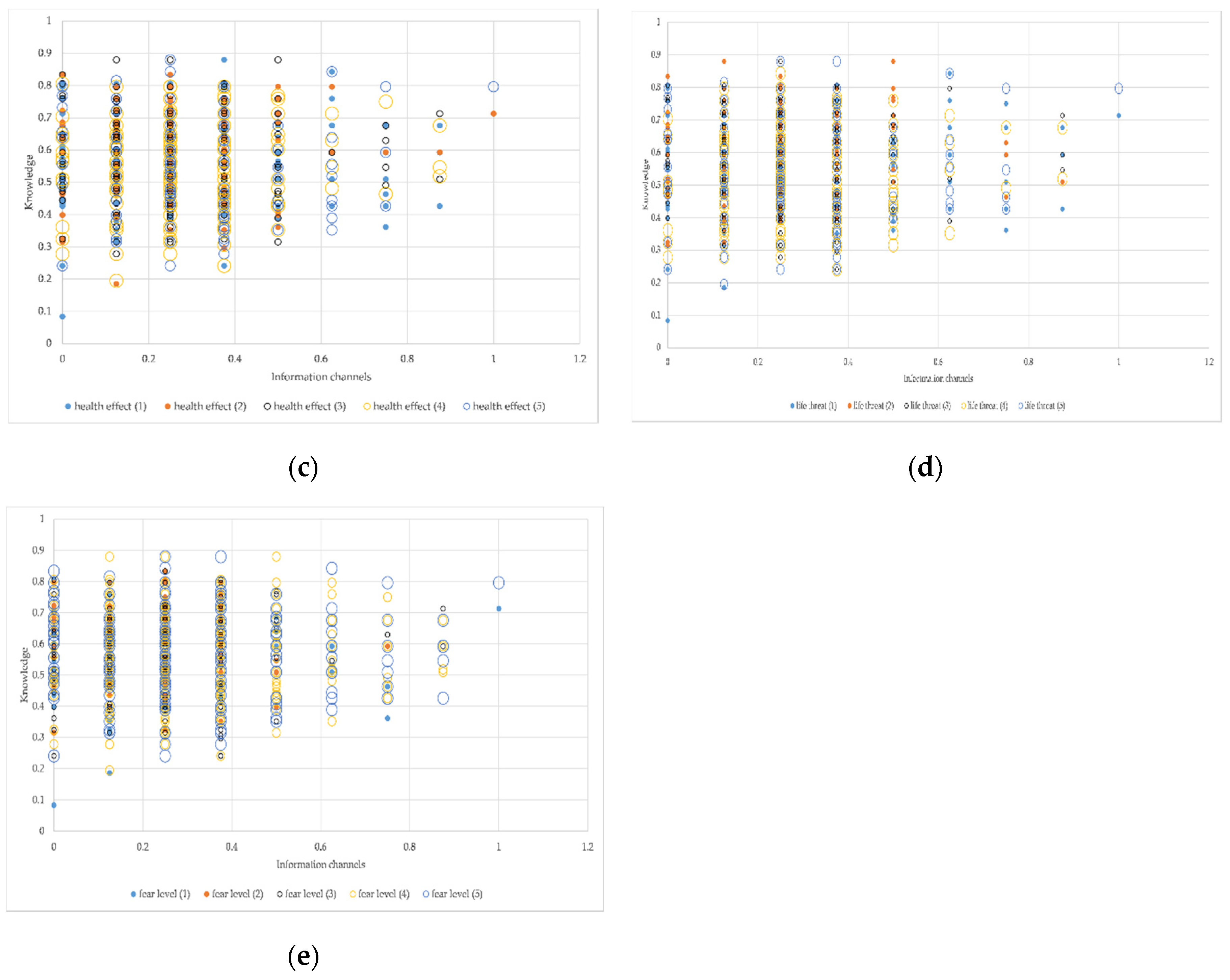
| Type | Name | Month |
|---|---|---|
| Severe Typhoon | Fanabi | September 2010 |
| Super Typhoon | Megi | October 2010 |
| Severe Typhoon | Nigg | October 2011 |
| Severe Typhoon | Vicente | July 2012 |
| Severe Typhoon | Tembin | August 2012 |
| Super Typhoon | Utor | August 2013 |
| Super Typhoon | Usagi | September 2013 |
| Severe Typhoon | Krosa | Nov. 2013 |
| Super Typhoon | Rammasun | July 2014 |
| Severe Typhoon | Mujigea | October 2015 |
| Super Typhoon | Meranti | September 2016 |
| Severe Typhoon | Megi | September 2016 |
| Super Typhoon | Sarika | October 2016 |
| Super Typhoon | Haima | October 2016 |
| Super Typhoon | Hato | August 2017 |
| Severe Typhoon | Khanun | October 2017 |
| Super Typhoon | Mangkhut | September 2018 |
| Super Typhoon | Yutu | October 2018 |
| Severe Typhoon | Wutip | February 2019 |
| Severe Typhoon | Lekima | August 2019 |
| Severe Typhoon | Lingling | September 2019 |
| Severe Typhoon | Hagibis | October 2019 |
| Severe Typhoon | Bualoi | October 2019 |
| Super Typhoon | Halong | Nov. 2019 |
| Severe Typhoon | Kammuri | Dec. 2019 |
| Overall Impact | Property Damage | Health Effects | Life Threat | Fear Level | ||
|---|---|---|---|---|---|---|
| Overall impact | Pearson | 1 | - | - | - | - |
| Property damage | Pearson | 0.330 *** | 1 | - | - | - |
| Health effects | Pearson | 0.251 *** | 0.777 *** | 1 | - | - |
| Life threat | Pearson | 0.207 *** | 0.701 *** | 0.822 *** | 1 | - |
| Fear level | Pearson | 0.369 *** | 0.298 *** | 0.291 *** | 0.316 *** | 1 |
| Item | Option | Overall Impact | Property Damage | Health Effect | Life Threat | Fear Level | ||||||||||
|---|---|---|---|---|---|---|---|---|---|---|---|---|---|---|---|---|
| Mean ± SD | t/F a | r b | Mean ± SD | t/F a | r b | Mean ± SD | t/F a | r b | Mean ± SD | t/F a | r b | Mean ± SD | t/F a | r b | ||
| Gender | Male | 1.869 | 3.35 ± 1.312 | 9.592 *** | 3.20 ± 1.296 | 11.200 *** | 3.30 ± 1.341 | 10.866 *** | −1.373 | |||||||
| Female | 2.56 ± 1.261 | 2.22 ± 1.372 | 2.31 ± 1.447 | |||||||||||||
| Age | 15–24 | 4.00 ± 1.010 | 2.316 * | 0.048 | 2.86 ± 1.340 | 41.738 *** | −0.343 ** | 2.75 ± 1.343 | 63.902 *** | −0.442 ** | 2.88 ± 1.414 | 70.483 *** | −0.469 ** | 3.35 ± 1.304 | 7.547 *** | 0.147 ** |
| 25–34 | 4.13 ± 0.875 | 3.36 ± 1.284 | 3.23 ± 1.325 | 3.41 ± 1.318 | 3.77 ± 1.095 | |||||||||||
| 35–44 | 4.29 ± 0.747 | 3.46 ± 1.274 | 3.23 ± 1.262 | 3.28 ± 1.331 | 3.84 ± 1.099 | |||||||||||
| 45–54 | 4.31 ± 0.655 | 3.18 ± 1.355 | 2.67 ± 1.243 | 2.56 ± 1.392 | 3.31 ± 1.436 | |||||||||||
| 55–64 | 3.89 ± 0.892 | 2.70 ± 1.409 | 2.48 ± 1.397 | 2.63 ± 1.275 | 3.44 ± 1.219 | |||||||||||
| 65 and above | 4.17 ± 0.815 | 1.90 ± 0.763 | 1.35 ± 0.790 | 1.35 ± 0.826 | 4.04 ± 1.210 | |||||||||||
| Education | Primary and below | 1.134 | −0.008 | 1.93 ± 0.789 | 52.355 *** | 0.325 ** | 1.35 ± 0.833 | 89.754 *** | 0.413 ** | 1.38 ± 0.896 | 93.219 *** | 0.421 ** | 4.11 ± 1.159 | 9.925 *** | −0.165 ** | |
| Secondary | 2.92 ± 1.689 | 2.70 ± 1.579 | 2.76 ± 1.480 | 3.38 ± 1.460 | ||||||||||||
| Higher secondary | 3.33 ± 1.305 | 3.23 ± 1.261 | 3.40 ± 1.300 | 3.63 ± 1.165 | ||||||||||||
| University | 3.29 ± 1.296 | 3.13 ± 1.323 | 3.23 ± 1.332 | 3.70 ± 1.146 | ||||||||||||
| Master and above | 2.80 ± 1.328 | 2.61 ± 1.276 | 2.74 ± 1.472 | 3.39 ± 1.321 | ||||||||||||
| Occupation | Legislators, government officials, community leaders, | 4.43 ± 0.573 | 2.556 ** | 3.36 ± 1.367 | 28.618 *** | 2.96 ± 1.478 | 35.487 *** | 3.32 ± 1.492 | 37.538 *** | 3.82 ± 1.249 | 3.575 *** | |||||
| business leaders and managers | ||||||||||||||||
| Professionals | 4.28 ± 0.743 | 3.59 ± 1.233 | 3.38 ± 1.235 | 3.45 ± 1.328 | 3.79 ± 1.175 | |||||||||||
| Technicians and support professionals | 4.18 ± 0.804 | 3.58 ± 1.148 | 3.33 ± 1.199 | 3.49 ± 1.212 | 3.72 ± 0.982 | |||||||||||
| Clerks | 4.17 ± 0.937 | 3.06 ± 1.375 | 2.86 ± 1.374 | 2.99 ± 1.418 | 3.72 ± 1.211 | |||||||||||
| Service and sales stuff | 3.94 ± 1.030 | 3.16 ± 1.344 | 2.91 ± 1.322 | 3.19 ± 1.331 | 3.68 ± 1.204 | |||||||||||
| Handicrafts-man | 4.41 ± 0.666 | 3.91 ± 0.971 | 3.73 ± 0.985 | 3.86 ± 1.082 | 3.82 ± 1.006 | |||||||||||
| Students | 3.93 ± 0.985 | 2.62 ± 1.274 | 2.60 ± 1.290 | 2.69 ± 1.353 | 3.29 ± 1.267 | |||||||||||
| Others | 4.17 ± 0.774 | 2.05 ± 0.930 | 1.45 ± 1.113 | 1.55 ± 1.186 | 4.20 ± 1.050 | |||||||||||
| Unemployed | 4.10 ± 0.878 | 1.96 ± 0.984 | 1.53 ± 0.941 | 1.50 ± 0.947 | 3.82 ± 1.315 | |||||||||||
| Item | Option | Overall Impact | Property Damage | Health Effect | Life Threat | Fear Level | ||||||||||
|---|---|---|---|---|---|---|---|---|---|---|---|---|---|---|---|---|
| Mean ± SD | t/F a | r b | Mean ± SD | t/F a | r b | Mean ± SD | t/F a | r b | Mean ± SD | t/F a | r b | Mean ± SD | t/F a | r b | ||
| Health condition | Relatively poor | 4.00 ± 1.044 | 5.035 ** | 0.122 ** | 3.17 ± 1.193 | 2.941 * | 0.088 ** | 3.08 ± 1.165 | 4.790 ** | 0.066 ** | 3.17 ± 1.267 | 3.429 ** | 0.051 | 1.763 | 0.01 | |
| Fair | 3.99 ± 0.956 | 2.58 ± 1.246 | 2.21 ± 1.293 | 2.36 ± 1.454 | ||||||||||||
| Relatively good | 4.04 ± 0.858 | 2.88 ± 1.281 | 2.75 ± 1.336 | 2.84 ± 1.395 | ||||||||||||
| Very good | 4.26 ± 0.831 | 2.99 ± 1.405 | 2.66 ± 1.509 | 2.74 ± 1.550 | ||||||||||||
| Place of residence | Macao | 0.327 | 2.80 ± 1.324 | 4.455 ** | 2.51 ± 1.422 | 6.399 *** | 2.61 ± 1.499 | 6.685 *** | 0.829 | |||||||
| Zhuhai | 3.27 ± 1.248 | 3.10 ± 1.269 | 3.00 ± 1.311 | |||||||||||||
| Guangdong | 3.22 ± 1.402 | 3.07 ± 1.421 | 3.40 ± 1.377 | |||||||||||||
| Others | 2.88 ± 1.654 | 2.82 ± 1.380 | 2.71 ± 1.448 | |||||||||||||
| Whether to live in areas susceptible to typhoon | −2.592 * | −3.580 *** | −4.527 *** | −4.161 *** | −0.611 | |||||||||||
| Floor | Ground level and below | 0.841 | −0.042 | 3.92 ± 1.382 | 5.758 *** | 0.067 * | 3.69 ± 1.653 | 7.699 *** | 0.077 * | 3.54 ± 1.664 | 6.416 *** | 0.068 * | 4.31 ± 1.182 | 3.254 ** | −0.121 ** | |
| First floor | 2.41 ± 1.208 | 1.91 ± 1.387 | 1.98 ± 1.476 | 4.12 ± 1.150 | ||||||||||||
| 2nd–7th floor | 2.82 ± 1.334 | 2.61 ± 1.436 | 2.74 ± 1.501 | 3.73 ± 1.223 | ||||||||||||
| 8th–13th floor | 3.03 ± 1.361 | 2.72 ± 1.389 | 2.80 ± 1.463 | 3.70 ± 1.196 | ||||||||||||
| 14th–19th floor | 3.36 ± 1.195 | 3.19 ± 1.163 | 3.23 ± 1.213 | 3.63 ± 0.972 | ||||||||||||
| 20th–26th floor | 2.85 ± 1.313 | 2.58 ± 1.293 | 2.63 ± 1.327 | 3.45 ± 1.241 | ||||||||||||
| 27th floor and above | 2.77 ± 1.454 | 2.63 ± 1.424 | 2.61 ± 1.542 | 3.35 ± 1.561 | ||||||||||||
| Time to stay | From birth | 2.178 | 0.007 | 2.61 ± 1.415 | 12.020 *** | −0.095 ** | 2.44 ± 1.418 | 20.923 *** | −0.166 ** | 2.79 ± 1.440 | 16.078 *** | −0.172 ** | 3.41 ± 1.303 | 9.465 *** | 0.150 ** | |
| Over 10 years | 3.14 ± 1.288 | 3.00 ± 1.303 | 2.99 ± 1.355 | 3.56 ± 1.169 | ||||||||||||
| 5–10 years | 3.49 ± 1.151 | 3.31 ± 1.223 | 3.39 ± 1.226 | 3.75 ± 1.080 | ||||||||||||
| 1–5 years | 2.86 ± 1.389 | 2.73 ± 1.336 | 2.79 ± 1.443 | 3.55 ± 1.259 | ||||||||||||
| Less than 1 year | 2.64 ± 1.284 | 2.17 ± 1.461 | 2.28 ± 1.549 | 4.04 ± 1.155 | ||||||||||||
| Number of family members under 14 | 0 | 0.426 | 0.019 | 2.38 ± 1.220 | 42.244 *** | 0.332 ** | 2.05 ± 1.303 | 49.192 *** | 0.355 ** | 2.14 ± 1.399 | 44.525 *** | 0.336 ** | 1.097 | 0.039 | ||
| 1 | 3.30 ± 1.267 | 3.12 ± 1.290 | 3.27 ± 1.389 | |||||||||||||
| 2 | 3.53 ± 1.286 | 3.29 ± 1.325 | 3.28 ± 1.251 | |||||||||||||
| 3 | 3.68 ± 1.030 | 3.52 ± 1.262 | 3.52 ± 1.327 | |||||||||||||
| 4 and above | 3.30 ± 1.218 | 3.25 ± 1.293 | 3.60 ± 1.231 | |||||||||||||
| Number of family members above 65 | 0 | 4.05 ± 0.907 | 4.113 ** | 0.114 ** | 2.47 ± 1.216 | 43.191 *** | 0.383 ** | 2.19 ± 1.332 | 39.716 *** | 0.368 ** | 2.25 ± 1.404 | 42.220 *** | 0.362 ** | 1.68 | 0.079 * | |
| 1 | 4.20 ± 0.816 | 3.15 ± 1.344 | 2.96 ± 1.414 | 3.12 ± 1.415 | ||||||||||||
| 2 | 4.32 ± 0.770 | 3.67 ± 1.197 | 3.39 ± 1.230 | 3.60 ± 1.267 | ||||||||||||
| 3 | 4.05 ± 1.026 | 3.89 ± 1.243 | 3.58 ± 1.121 | 3.32 ± 1.204 | ||||||||||||
| Family members with limited mobility | 2.357 * | 9.496 *** | 10.333 *** | 10.130 *** | 2.246 * | |||||||||||
| Personal monthly income | ≤4999 | 1.676 | 0.031 | 2.24 ± 1.076 | 27.965 *** | 0.247 * | 1.88 ± 1.199 | 32.895 *** | 0.251 ** | 1.91 ± 1.239 | 35.696 *** | 0.275 ** | 1.313 | −0.035 | ||
| 5000–9999 | 3.24 ± 1.366 | 3.08 ± 1.367 | 3.26 ± 1.385 | |||||||||||||
| 10,000–14,999 | 3.67 ± 1.131 | 3.55 ± 1.203 | 3.57 ± 1.303 | |||||||||||||
| 15,000–19,999 | 3.43 ± 1.279 | 3.10 ± 1.274 | 3.35 ± 1.281 | |||||||||||||
| 20,000–24,999 | 3.45 ± 1.276 | 3.18 ± 1.287 | 3.31 ± 1.350 | |||||||||||||
| 25,000–29,999 | 3.07 ± 1.163 | 3.12 ± 1.219 | 3.44 ± 1.181 | |||||||||||||
| 30,000–39,999 | 2.76 ± 1.422 | 2.63 ± 1.460 | 2.53 ± 1.466 | |||||||||||||
| 40,000–59,999 | 3.14 ± 1.456 | 2.76 ± 1.480 | 3.03 ± 1.500 | |||||||||||||
| ≥60,000 | 3.52 ± 1.418 | 3.04 ± 1.338 | 3.28 ± 1.487 | |||||||||||||
| Overall Impact | Property Damage | Health Effects | Life Threat | Fear Level | |||||||
|---|---|---|---|---|---|---|---|---|---|---|---|
| F a | r b | F a | r b | F a | r b | F a | r b | F a | r b | ||
| Knowledge | Knowledge of typhoon signal | 3.983 * | −0.035 | 2.649 | 0.072 * | 1.899 | 0.043 | 2.813 | 0.02 | 9.351 *** | −0.079 * |
| Understanding of typhoon prevention | 2.622 * | −0.077 * | 14.332 *** | −0.182 *** | 9.886 *** | −0.138 *** | 8.068 *** | −0.120 *** | 3.692 ** | −0.063 * | |
| Knowledge of typhoon preparedness | 2.592 ** | 0.061 | 9.098 *** | −0.187 *** | 14.833 *** | −0.202 *** | 13.129 *** | −0.213 *** | 3.286 ** | 0.054 | |
| Knowledge (Weighted score) | −0.037 | −0.142 ** | −0.146 ** | −0.158 ** | −0.065 * | ||||||
| Numbers of information channels | 3.396 ** | 0.124 *** | 6.485 *** | −0.04 | 13.455 *** | −0.112 *** | 15.175 *** | −0.139 *** | 10.599 *** | 0.246 *** | |
| Active response to typhoon | 13.353 *** | 0.202 ** | 21.593 *** | 0.277 ** | 23.674 *** | 0.259 ** | 21.012 *** | 0.247 ** | 12.529 *** | 0.204 ** | |
© 2020 by the authors. Licensee MDPI, Basel, Switzerland. This article is an open access article distributed under the terms and conditions of the Creative Commons Attribution (CC BY) license (http://creativecommons.org/licenses/by/4.0/).
Share and Cite
Shen, Y.; Lou, S.; Zhao, X.; Ip, K.P.; Xu, H.; Zhang, J. Factors Impacting Risk Perception under Typhoon Disaster in Macao SAR, China. Int. J. Environ. Res. Public Health 2020, 17, 7357. https://doi.org/10.3390/ijerph17207357
Shen Y, Lou S, Zhao X, Ip KP, Xu H, Zhang J. Factors Impacting Risk Perception under Typhoon Disaster in Macao SAR, China. International Journal of Environmental Research and Public Health. 2020; 17(20):7357. https://doi.org/10.3390/ijerph17207357
Chicago/Turabian StyleShen, Yajing, Shiyan Lou, Xiujuan Zhao, Kuai Peng Ip, Hui Xu, and Jingwen Zhang. 2020. "Factors Impacting Risk Perception under Typhoon Disaster in Macao SAR, China" International Journal of Environmental Research and Public Health 17, no. 20: 7357. https://doi.org/10.3390/ijerph17207357
APA StyleShen, Y., Lou, S., Zhao, X., Ip, K. P., Xu, H., & Zhang, J. (2020). Factors Impacting Risk Perception under Typhoon Disaster in Macao SAR, China. International Journal of Environmental Research and Public Health, 17(20), 7357. https://doi.org/10.3390/ijerph17207357





